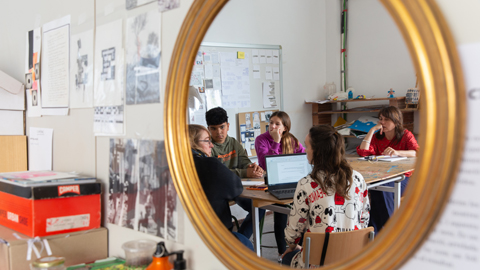Teachers, children, artists and students explore how artistic language leads to better learning
The UAB has spent months exploring artistic language as a new learning paradigm under the framework of the European project it is coordinating, Interstice. The project includes the involvement of scenic and visual artists and universities from Catalonia, the UK, Italy and Norway. On Wednesday 25 May artist Rosa Llop conducted a session at the primary school Josep Ma de Sagarra in Barcelona, in which pupils and teachers, as well as UAB students and researchers, participated.

Does artistic language foster the critical conscious of children during the process of learning? What nuances does art unfurl while they learn? How can artistic practices contribute to the role of educators?
These are some of the questions that were included in a session conducted by artist Rosa Llop on Wednesday 25 May as part of the subject on “Regions of Contemporary Art As Learning Spaces”, offered by artist and lecturer Gemma París in the UAB bachelor's degrees in Early Childhood Education and Primary Education. The session was conducted at the Josep Ma de Sagarra primary school in Barcelona.
Rosa Llop is resident artist at the Hangar Institute and collaborates in the European project to have resident artists at primary schools, entitled "Espais C. Artistes residents a escoles de primària". The project is coordinated by the Institute of Culture of Barcelona and the Education Consortium, with the collaboration of the EART and the UAB.
The session offered by artist Rosa Llop, which was an experience-based session lasting two hours, was an ideal way to bring into contact educators from the Josep Maria de Sagarra primary school and some thirty students from the education degrees offered at the UAB (and therefore future teachers), so that they could jointly explore, in a creative fashion, the ways artistic language mediation could contribute to a critical and creative teaching methodology.
This session was the last one to be implemented by the UAB, with collaboration with local and international visual and scenic artists, under the framework of the European research project entitled “Interstice, encounters between artists, children and educators”, whose objective is to make the educative learning which will be implemented through art by future educators be done from a space of contemporary art and creation, thereby changing the paradigm of what art can provide to the education of children.
According to the coordinators of the Interstice Project and the lecturers at the UAB Faculty of Education, Gemma París and Sílvia Blanch, "the idea is to soften the lines between art and education, and to make the learning process equal for artists, educators and education students". "Exploring artistic language in the classroom does not amount to doing arts&crafts, we are talking about something completely different, that goes beyond anything like that; a shift in the teaching paradigm", the UAB lecturers say.
Artist Rosa Llop has been offering these sessions since January. She conducted a collective thinking action focused on representations of time within the school, then in an art centre, and later at the Faculty of Education, with the aim of setting down the foundations of this new educational paradigm.
The objective is to "not only have an artist working at the school so that children can discover their conceptual strategies, but also have schools visit artistic centes, and for these centres to become educational centres", explain the coordinators of the project.
A project covering the whole of Europe
The Interstice Project - funded by the European Commission as part of its Erasmus+ programme - has been functioning since 2020 at universities, with artists and in cultural areas in Catalonia, the United Kingdom, Italy and Norway, with the aim of promoting points of union among educators, artists and children as a way of improving learning processes and building and educational methodology based on co-creations.
During the 2021/22 academic year, each country's consortium partner participated in their area of expertise, both in visual arts and in scenic arts, by working with educators and children at schools and also with students of education degrees. At the UAB, the artists participating form part of the Espai C project and the La Sala Theatre group in Sabadell, who were in charge of researching the processes and effects of collaborative learning between primary school educators and contemporary dance artists from Europe. At the same time, training was provided for future educators in the new educating-through-the-arts paradigm.
“Interstice. Encounters between artists, children and educators” (Erasmus+, Strategic Partnerships).
Projects by countries: https://www.interstice.eu/projects
Social media: @interstice_eu